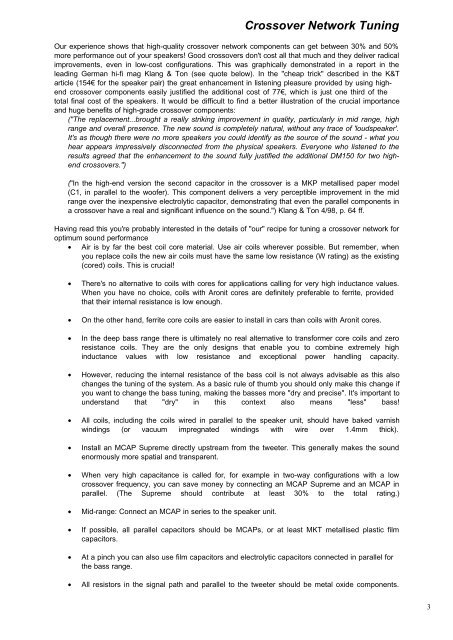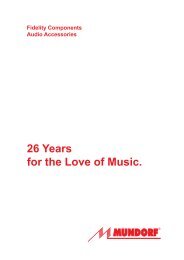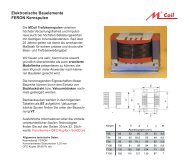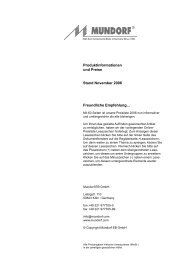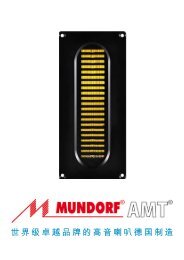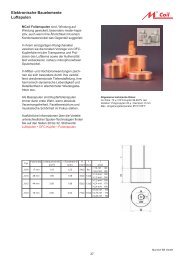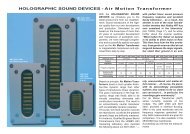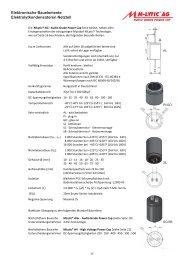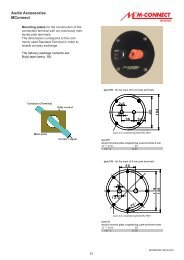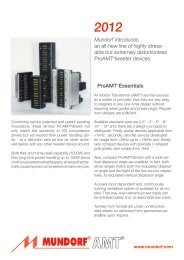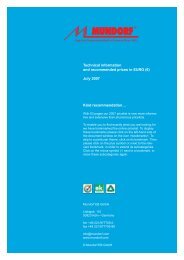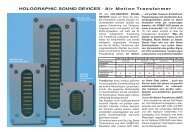You also want an ePaper? Increase the reach of your titles
YUMPU automatically turns print PDFs into web optimized ePapers that Google loves.
Crossover Network Tuning<br />
Our experience shows that high-quality crossover network components can get between 30% and 50%<br />
more performance out of your speakers! Good crossovers don't cost all that much and they deliver radical<br />
improvements, even in low-cost configurations. This was graphically demonstrated in a report in the<br />
leading German hi-fi mag Klang & Ton (see quote below). In the "cheap trick" described in the K&T<br />
article (154€ for the speaker pair) the great enhancement in listening pleasure provided by using highend<br />
crossover components easily justified the additional cost of 77€, which is just one third of the<br />
total final cost of the speakers. It would be difficult to find a better illustration of the crucial importance<br />
and huge benefits of high-grade crossover components:<br />
("The replacement...brought a really striking improvement in quality, particularly in mid range, high<br />
range and overall presence. The new sound is completely natural, without any trace of 'loudspeaker'.<br />
It's as though there were no more speakers you could identify as the source of the sound - what you<br />
hear appears impressively disconnected from the physical speakers. Everyone who listened to the<br />
results agreed that the enhancement to the sound fully justified the additional DM150 for two highend<br />
crossovers.")<br />
("In the high-end version the second capacitor in the crossover is a MKP metallised paper model<br />
(C1, in parallel to the woofer). This component delivers a very perceptible improvement in the mid<br />
range over the inexpensive electrolytic capacitor, demonstrating that even the parallel components in<br />
a crossover have a real and significant influence on the sound.") Klang & Ton 4/98, p. 64 ff.<br />
Having read this you're probably interested in the details of "our" recipe for tuning a crossover network for<br />
optimum sound performance<br />
• Air is by far the best coil core material. Use air coils wherever possible. But remember, when<br />
you replace coils the new air coils must have the same low resistance (W rating) as the existing<br />
(cored) coils. This is crucial!<br />
• There's no alternative to coils with cores for applications calling for very high inductance values.<br />
When you have no choice, coils with Aronit cores are definitely preferable to ferrite, provided<br />
that their internal resistance is low enough.<br />
• On the other hand, ferrite core coils are easier to install in cars than coils with Aronit cores.<br />
• In the deep bass range there is ultimately no real alternative to transformer core coils and zero<br />
resistance coils. They are the only designs that enable you to combine extremely high<br />
inductance values with low resistance and exceptional power handling capacity.<br />
• However, reducing the internal resistance of the bass coil is not always advisable as this also<br />
changes the tuning of the system. As a basic rule of thumb you should only make this change if<br />
you want to change the bass tuning, making the basses more "dry and precise". It's important to<br />
understand that "dry" in this context also means "less" bass!<br />
• All coils, including the coils wired in parallel to the speaker unit, should have baked varnish<br />
windings (or vacuum impregnated windings with wire over 1.4mm thick).<br />
• Install an MCAP Supreme directly upstream from the tweeter. This generally makes the sound<br />
enormously more spatial and transparent.<br />
• When very high capacitance is called for, for example in two-way configurations with a low<br />
crossover frequency, you can save money by connecting an MCAP Supreme and an MCAP in<br />
parallel. (The Supreme should contribute at least 30% to the total rating.)<br />
• Mid-range: Connect an MCAP in series to the speaker unit.<br />
• If possible, all parallel capacitors should be MCAPs, or at least MKT metallised plastic film<br />
capacitors.<br />
• At a pinch you can also use film capacitors and electrolytic capacitors connected in parallel for<br />
the bass range.<br />
• All resistors in the signal path and parallel to the tweeter should be metal oxide components.<br />
3


